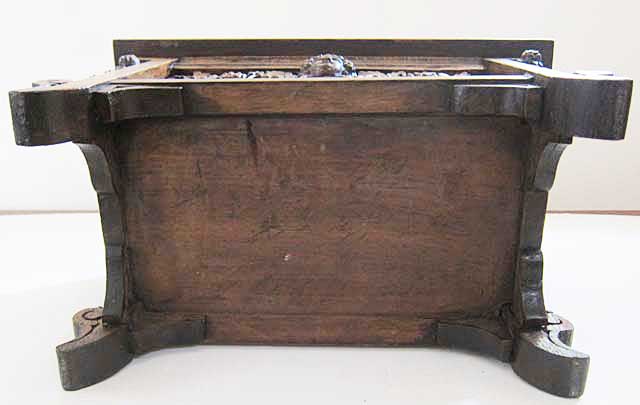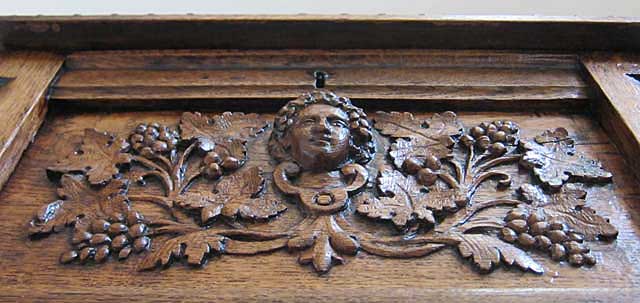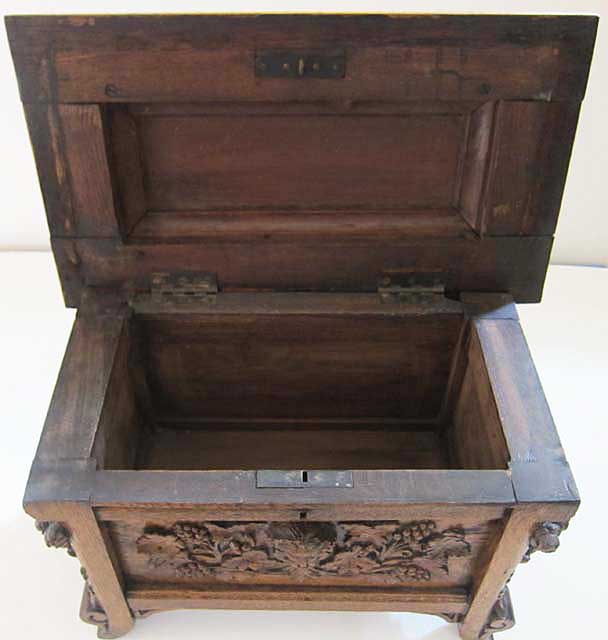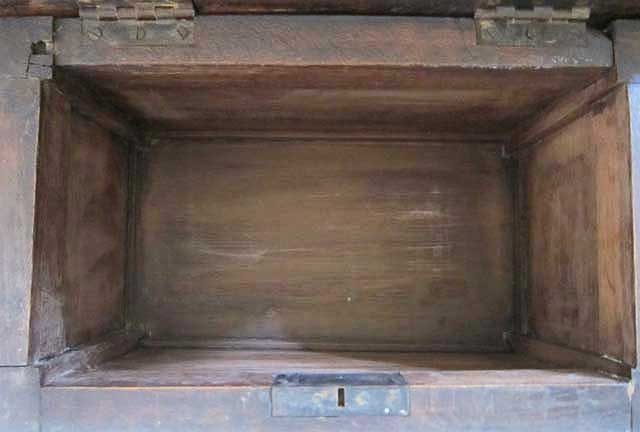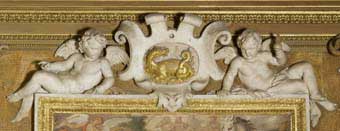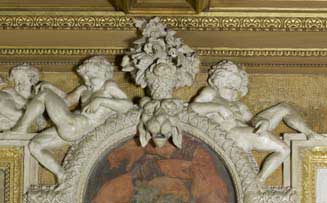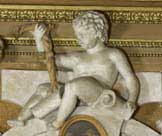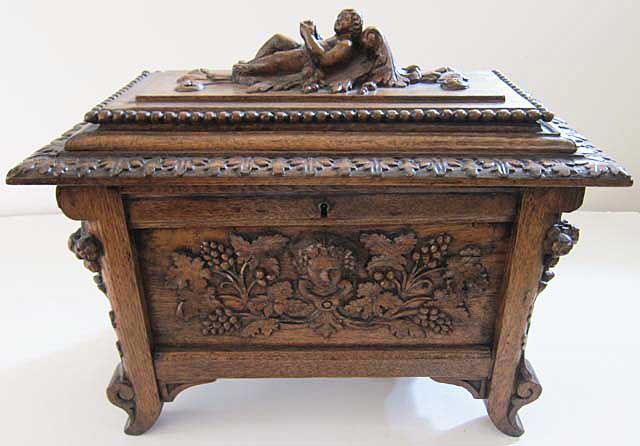
This exquisitely carved, small oak chest or coffret from the 19th century has its roots in the heady times of centuries earlier when Renaissance design swept north from Italy and dominated French decorative arts for generations. As we will discuss below, this box is heavily dependent on figures created by Rosso Fiorentino (1494-1540) in plaster surrounding his frescoes in the Galerie François I at the Chateau of Fontainebleau, a small hunting lodge transformed by King François I (reigned 1515-1547) into one of his most regal residences. For more about this, see the Renaissance section of our page on the Stylistic Origins of the items in our collection along with an article about our most recent visit to the Château de Fontainebleau.
Each of the four sides of our box is exquisitely carved and distinct from the others.
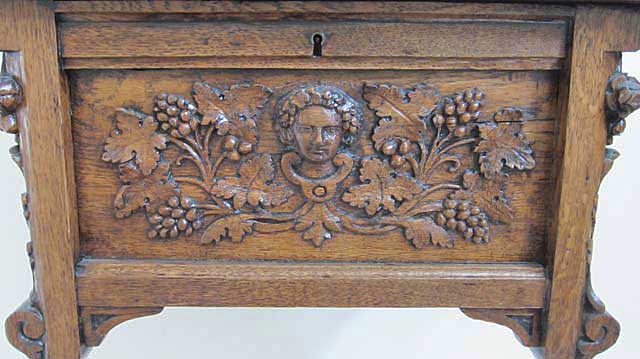
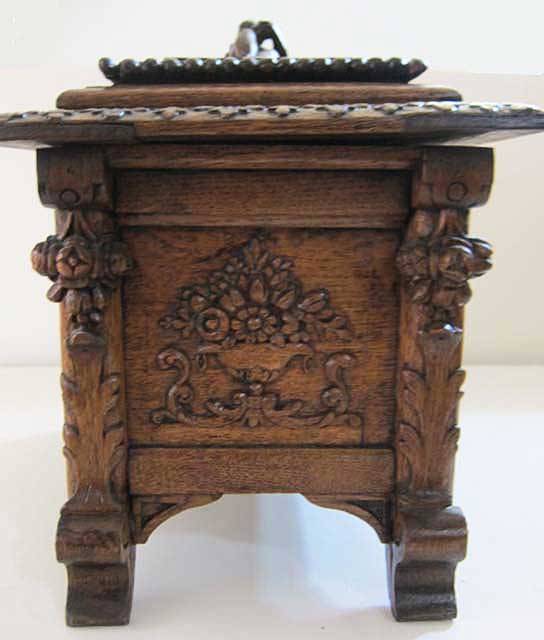
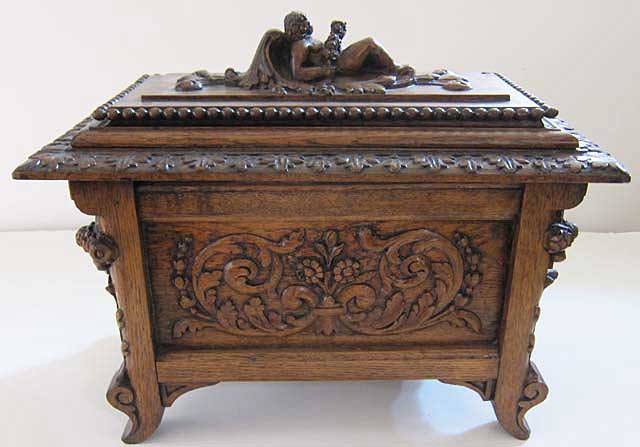
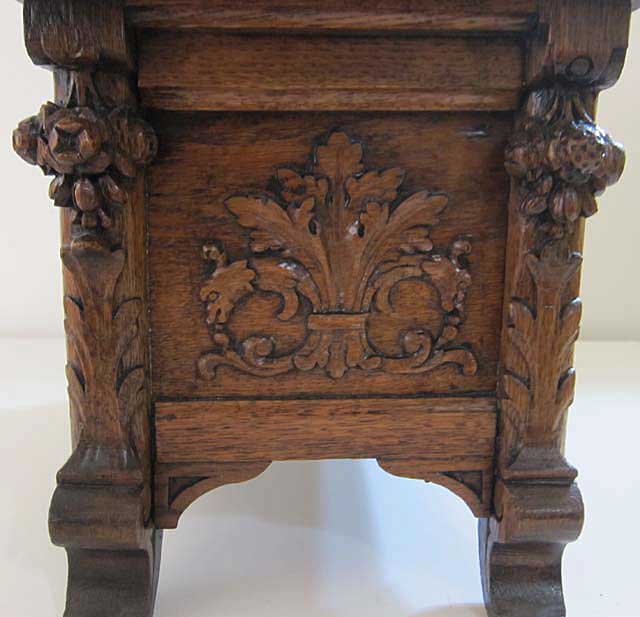
The beauty of the carving is especially remarkable in that the box is made from solid oak, one of the hardest of woods and most challenging to carve, rather than somewhat softer walnut preferred in Renaissance times. Bunches of grapes, grape leaves, acanthus leaves, flowers arranged in vases, garlands of fruit, scrollwork, volutes, fleurs-de-lys, and a putto, all reflect a stylistic vocabulary rooted in the Galerie François I at Fontainebleau.
Grape clusters and leaves abound on the front panel of the box, making it unmistakable that the head in the center is that of Bacchus, the Roman god of wine (or Dionysius, his Greek counterpart).
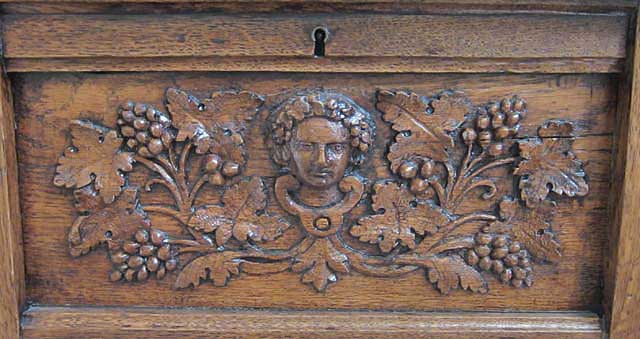
Bacchus is shown in his customary guise with a head of curly hair, looking young and ready for the adventure of traveling the world, advising on how to grow grapes and make wine. Perhaps as a nod to Rosso, the face and hair resemble closely the figure of Mars from a drawing done before he came to France but reproduced in France and in numerous publications during the Renaissance and later times.
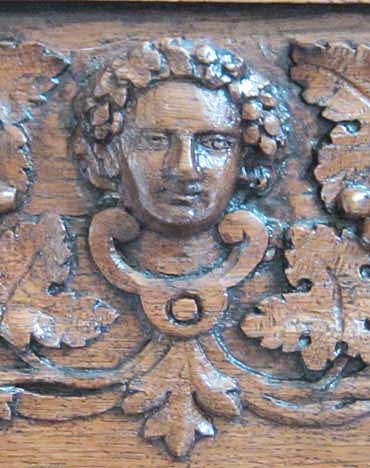
Swirling to the left and right of Bacchus is a complex design of grapes and grape leaves. Each grape is intricately and individually carved, as if inviting us to reach out and pluck a few.
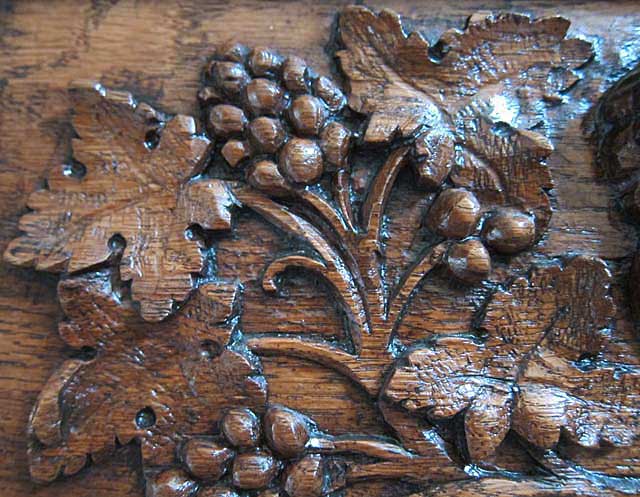
On the right side of the panel, a small crack has developed between the grapes and the frame, running through the top of a grape leaf but not affecting the stability of the box's structure.
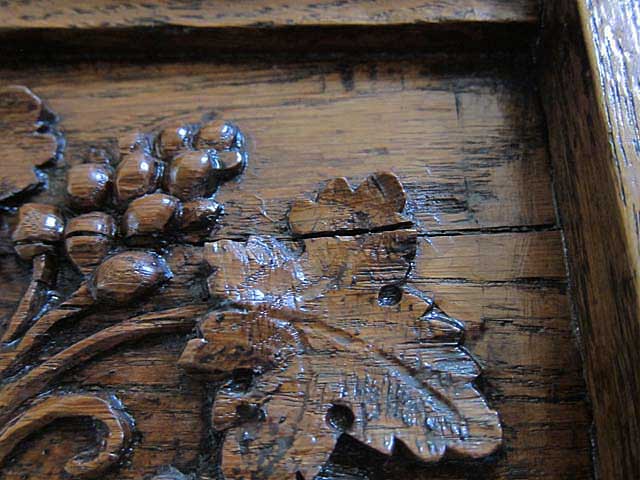
The left side of the box is decorated with a panel based on a footed vase overflowing with flowers. On either side of the panel is an acanthus leaf extending upward from the bottom and topped by an arrangement of hanging blossoms.
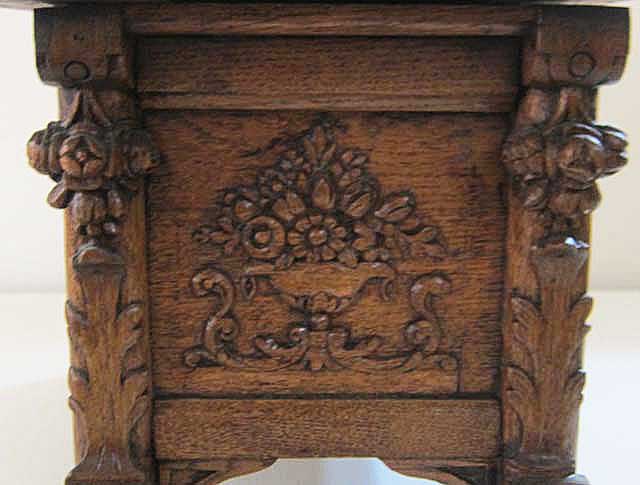
Reminiscent of Rosso's designs as seen in the Galerie François I at Fontainebleau where blossoms in bunches extended into garlands with fruit and leaves, these clusters are more abbreviated but still evoke the Renaissance imagery as a useful ornament for corners.
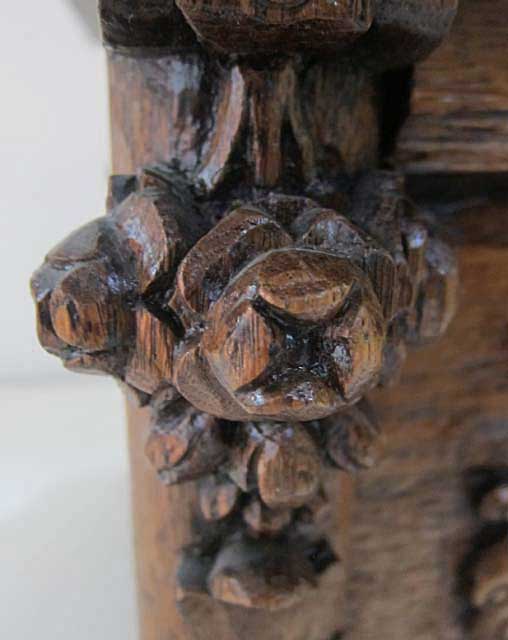
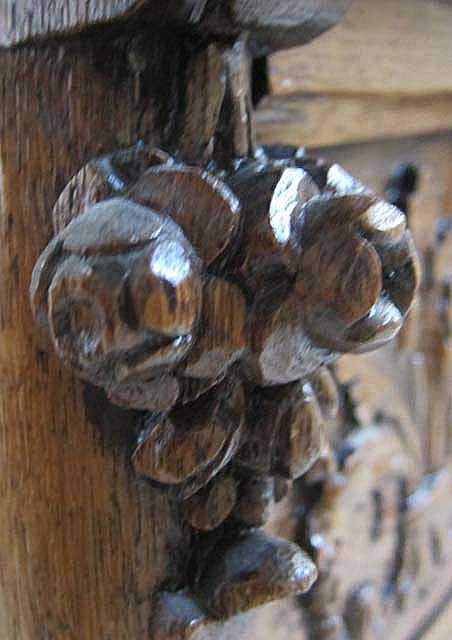
The individual flowers, emerging above the vase on the left side panel, include tulips and a daisy at the center as well as three-lobed lilies (or fleurs-de-lys) along the perimeter. At the base of the panel are volutes in the form of curled acanthus leaves used to frame the lower part of the image.
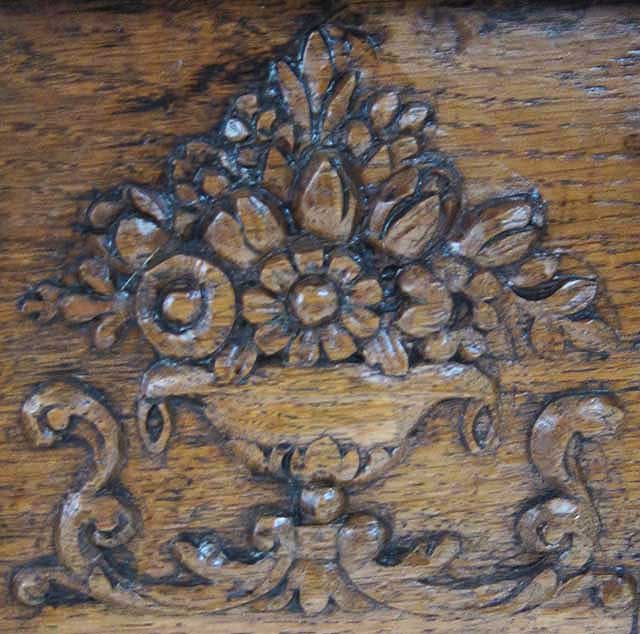
The back of the coffret is also intricately carved, underscoring the importance of the box as a decorative item to be admired from all sides and not just from the front.
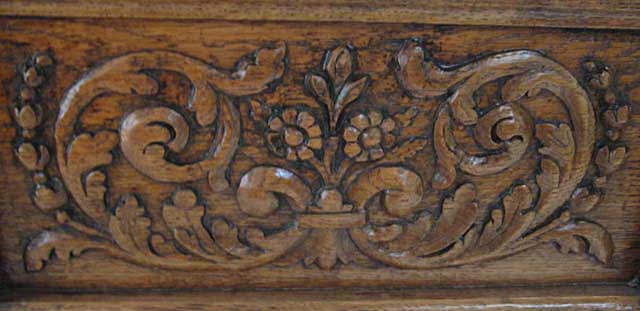
A floral display is at the center of the back panel, with two daisies as its focus and a lily above them, echoing the vegetation from the panel on the left side. The design of this flower arrangement, at the center, itself evokes a fleur-de-lys in that there is a band across it, just below the mid-point, and above it are three "lobes" — two daisies on either side and the lily at the top.
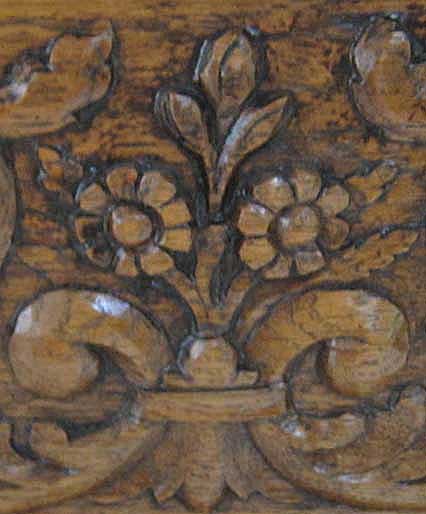
In contrast to the side panel, on the back the floral arrangement is smaller and the volutes of acanthus leaves take up proportionately more of the design as if to affirm the box's origins in Renaissance style.
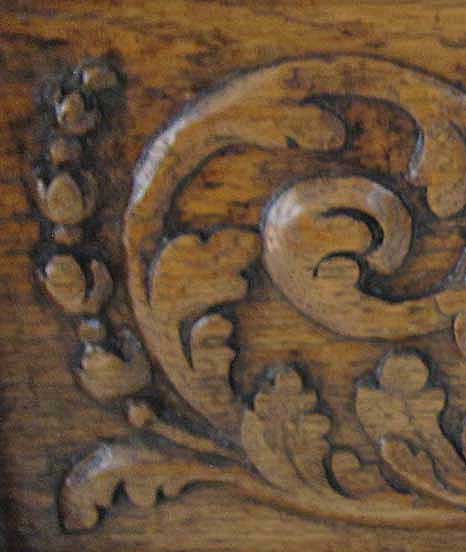
The right side of the box differs from the left, having as its focus an arrangement of acanthus leaves as a bouquet. In its overall shape, it too evokes the three-lobed design of a fleur-de-lys.
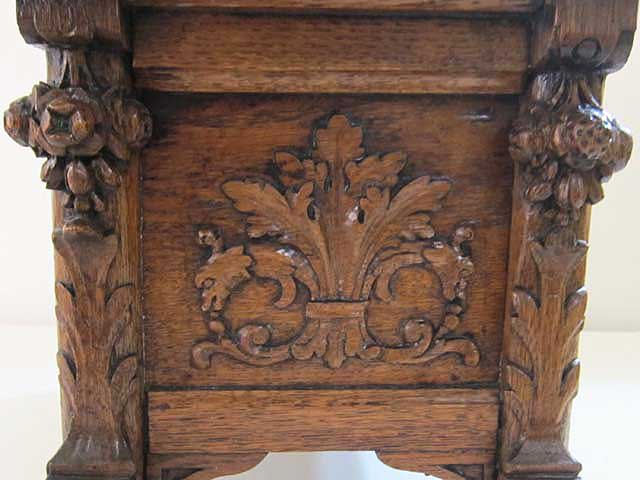
As with the panel on the left side of the box, at the bottom is a similar design of curled acanthus leaves.
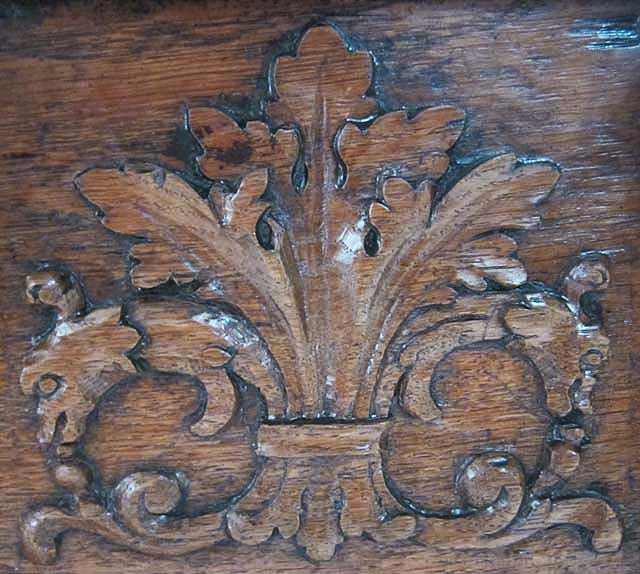
Two decorative borders around the top of the box include the pearl motif typical of Renaissance decoration and one of palmettes alternating with stylized fleurs-de-lys.
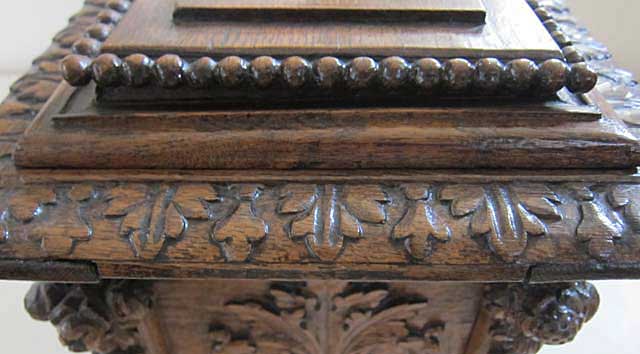
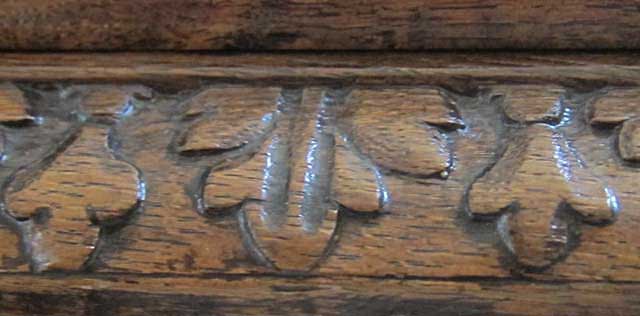
The many references to fleurs-de-lys, both in flowers represented in the carvings and in overall tripartite shapes, validate the French origins of this box despite the many references to Italian design elements. One could argue that the fleur-de-lys is truly Italian anyway, what with its importance as a symbol of the city of Florence. But the fleur-de-lys was used by French royalty since medieval times and incorporated into many pieces we have offered over the years such as Cabinet 1035, Chest 1034, and Table 9210, even after revolution had eliminated the monarchy.
At the base of the box, both front and back, are legs that curve slightly outward and are ornamented by curled figures. These resemble the strap work designs employed by Rosso at Fontainebleau and by his devotés including furniture designers such as Jacques Androuet du Cerceau.
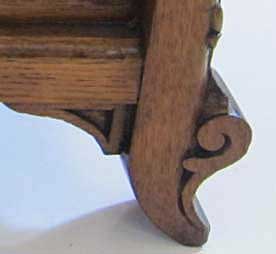
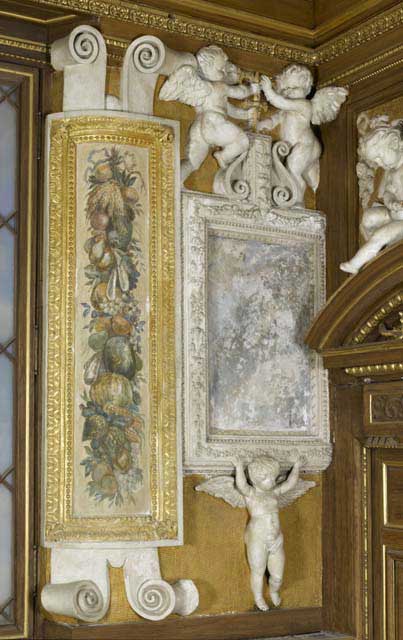
On the top of the box, the figure of a boy or putto reclines on a chaise longue of sculpted acanthus leaves and other vegetation, staring dreamily into space while clutching a garland of fruit (chute de fruits).
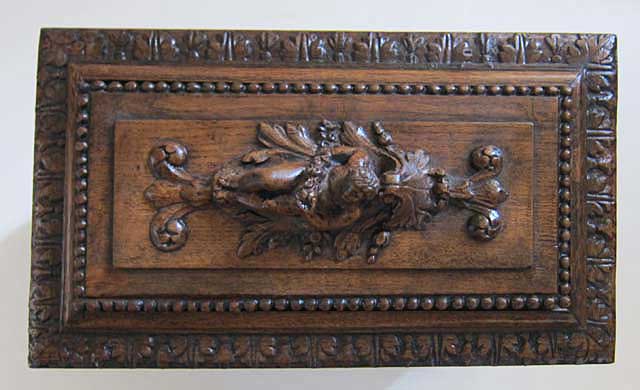
Not old enough to drink wine, at least in the U.S., he amuses himself with this other bounty of agriculture. Perhaps he is a younger version of the Bacchus whose head we see on the front of the box, or just another pre-pubescent figure such as those accompanying Bacchus in painterly portrayals of his adventures.
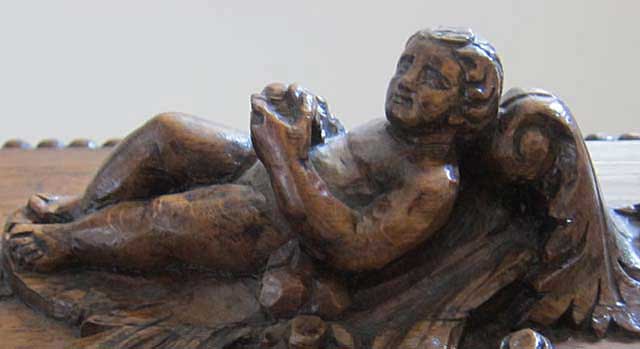
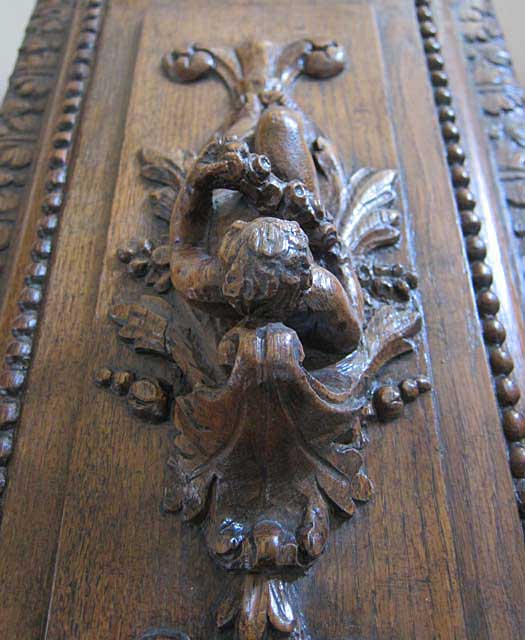
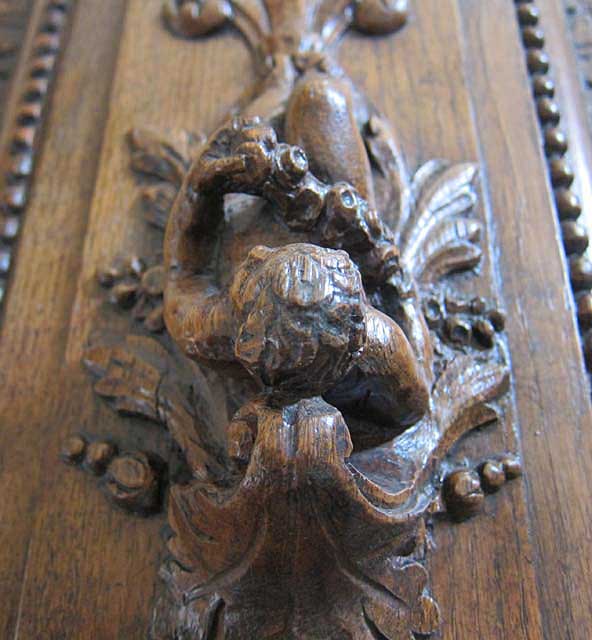
With his head, crowned by tousled curls and slightly cocked, he gazes off toward his left. His intricately sculpted features portray a vacant expression, perhaps one of contentment or even ennui, as he fingers the elements of the garland. Engaging with us as onlookers, he tempts us to lift the lid and discover treasures hidden below his perch.
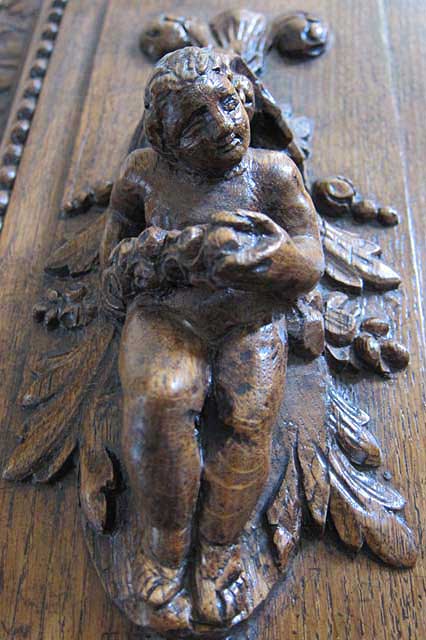
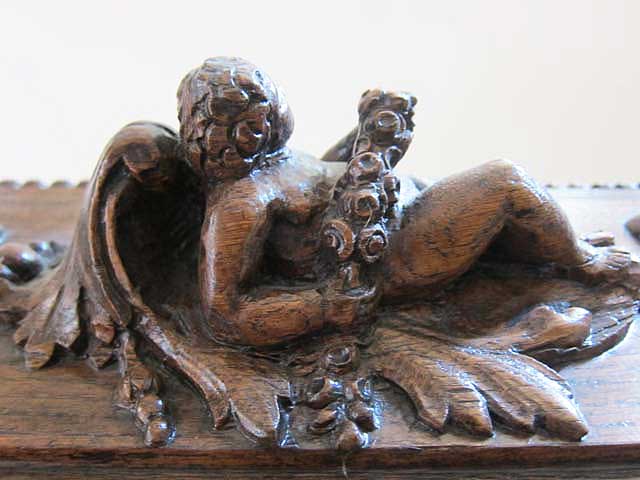
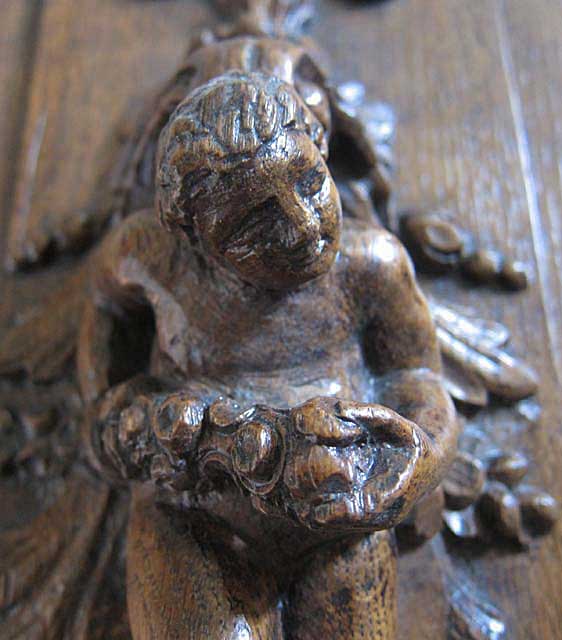
Barefoot, as if poised to scamper off into a vineyard, his toes are precisely carved as they rest on the tip of an acanthus leaf above an inverted figure of a fleur-de-lys.
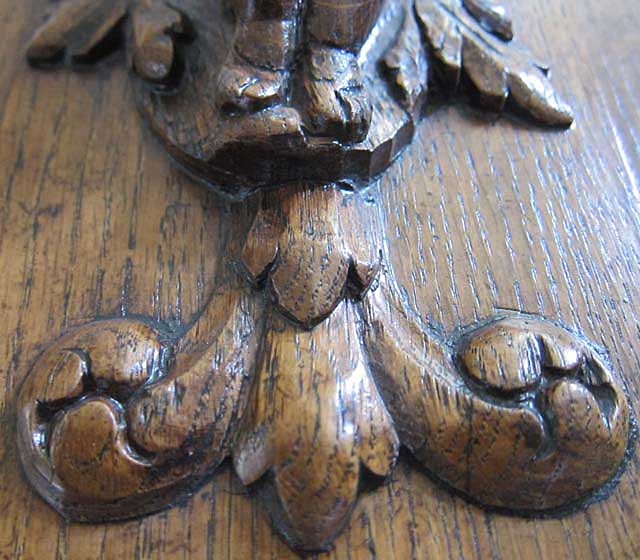
The putto as an image in art dates back well before the Renaissance to ancient cultures on the Italian peninsula such as the Etruscans and the Romans. A putto is always male and always a child, though that may vary from chubby infant to pre-teen youth. Sometimes putti have wings but they are not obligatory. In ancient times, they were depicted with Cupid and Venus (and also called erotes) as well as with Bacchus and Dionysius where they symbolized the abundance of fruit and the enjoyment of grapes in the form of wine. For example, the Etruscans depicted them in groups divided by garlands of flowers or fruits, a motif soon appropriated by the Romans. It was not until the Baroque period that they were seen more commonly, in their winged form, as angels in religious paintings.
In ancient depictions of putti they were engaged in all sorts of escapades, including driving chariots and cavorting with garlands, as shown on this Roman sarcophagus that we photographed on a recent visit to the Metropolitan Museum of Art. Clearly, their spirited images and mischievous tendencies were highly valued millennia ago.
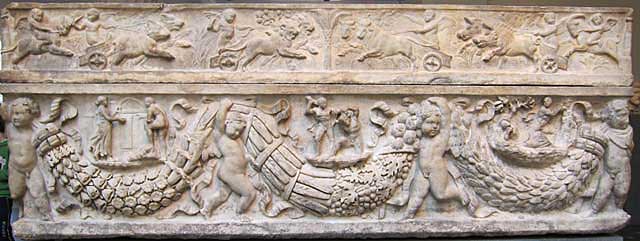
When artists in early 16th century Rome rediscovered ancient buildings under the city's more modern foundations, they too did not hesitate to adopt the rich decorative vocabulary of another culture as their own. Whether Raphael and his elaboration of grotesque decorative panels or Rosso and his putti, the Italian artists of the Renaissance used them widely in paintings, sculpture, and architecture. Perhaps one of the most recognizable of Renaissance putti is the one called musicante, a small painting by Rosso in the collection of the Uffizi Gallery in his hometown.
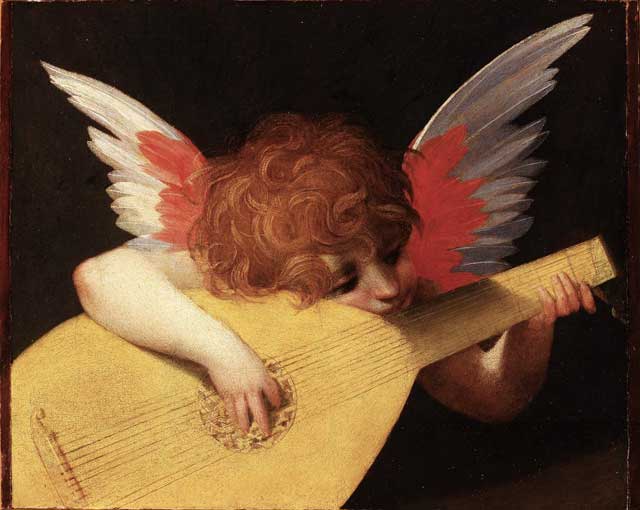
An academic inclination elevating painting over decorative arts appears to have limited the acknowledgement of the ground-breaking aspects of the three-dimensional plaster frames that Rosso created for his frescoes. Despite this, these stucs influenced countless artisans, including furniture designers, for generations to come through books of prints and engravings of his designs made by contemporary and later artists. These circulated around Europe for centuries and are now preserved in museums. While Rosso may not have been the originator of all of the images he used in his design for the Galerie, he absorbed and made great use of what he saw while working in Rome and what he learned from other artists he encountered there before heading to France.
As a precursor to King Louis XIV's Hall of Mirrors at the Palace of Versailles, it is likely that the Galerie at Fontainebleau shared similar objectives. In appointing Rosso to decorate the Galerie, it is possible that King François I's goals included: to celebrate his stature as the monarch; to promote his standing among his European peers (especially Habsburg Emperor Charles V); and to bring pleasure to himself and his entourage whenever resident there. In achieving all this, Rosso's works were a triumph. The king treasured them so much that he opened a tapestry workshop at the castle to make copies — not just of the frescoes but of their stucco frames as well — so he could take them along when he moved from residence to his among his other palaces and castles. These tapestries now reside at the Kunsthistorisches Museum in Vienna.
Throughout the Galerie François I, three-dimensional putti, male and female figures, satyrs, dogs, and salamanders (the king's emblem) populate frame after frame as the visitor explores the long narrow gallery and gazes upward at Rosso's masterpieces.
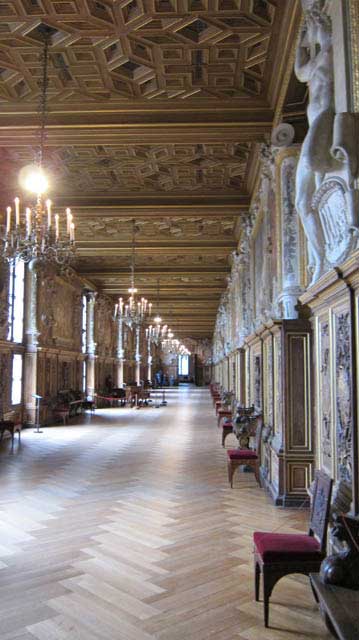
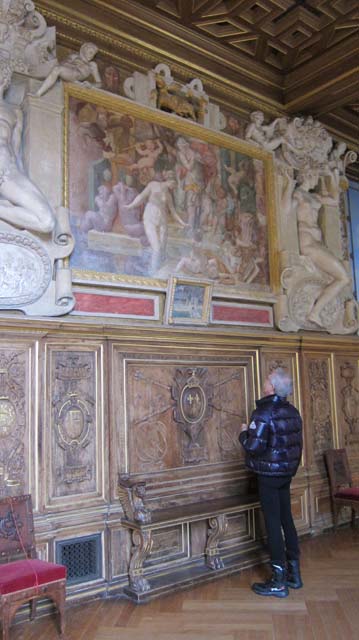
The putti in particular are engaged in all manner of activities evoking the freewheeling antics of the putti of ancient Rome, from propping up frames and niches, to looking out over them, to thrusting a toe into the viewer's space, to playing with garlands, to interacting with one another, and to reclining in mischievous poses on the tops of pediments. These must have given great pleasure to the King as well as to his visitors required to traverse the vast Galerie before meeting him. To examine the stuccoes in more detail and to see the putti in action, we suggest this page from the official website of French National Museums.
It is impossible to discuss the tiny figure atop our box without wondering where its creator found his inspiration for it. Did he know intimately the stuccoes at Fontainebleau? Did he consult one of the many collections of prints and engravings by other artists who copied Rosso's designs and published them in books used in furniture workshops all over France?
The following image of putti reclining on a frame is from a set of engravings inspired by Rosso's stuccoes at Fontainebleau. The artist, Léonard Thiry (1500-1550), was an assistant to Rosso at the chateau, and the engraver was René Boyvin (1525-1598). Together, they created a series of engravings illustrating the legend of the quest for the Golden Fleece but adapting images from Rosso's Galerie. This detail, from Plate 15 of the set, is in the Collection of the Victoria & Albert Museum.

If the creator of our box took his designs directly from Fontainebleau, the inspiration might have come from any of the abundance of putti, such as the following ones reclining in the Galerie François I.
While we will never know how the creator of this box came to select the images he carved so masterfully into it, the road map is clear. It leads us inexorably to the massive castle in the forest south of Paris and to a King made memorable by the genius of Rosso Fiorentino. And while the owner of this box may choose to place his or her own treasures inside it, the box itself is both a treasure and a tribute to Rosso Fiorentino's exquisite designs.
By the time we acquired the box, the key to it was long gone. Barely noticeable from the front, the box does not close completely on the left side, as shown in this photo taken from the side, due to a slight warp.
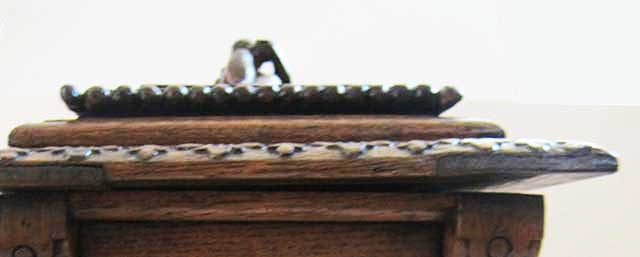
For more information about King François I and his massive building projects beyond Fontainebleau, see our article about the Loire Valley.
For other items in our collection involving elements on display in Rosso's designs for the Galerie François I, our page dedicated to Renaissance design and, in particular, see Mirror 9227, Table 5219, Chest 5154, Bench 5220, and Sgabelli 5334.
The most representative color, given the challenges of photographing wood furniture, is in the image at the top of this page.
Reference
Bos, Agnès, Mobilier du Moyen Age et de la Renaissance — La Collection du Musée du Louvre (Editions du Musée du Louvre/Somogy, Paris, 2019); Carroll, Eugene A., Rosso Fiorentino, Drawings, Prints, and Decorative Arts (National Gallery of Art, Washington, D.C., 1987); Carroll, Eugene A., Rosso Fiorentino — Paintings, Drawings, Prints, and Architecture, (On line from Vassar College, Poughkeepsie, 2016); Crépin-Leblond, Thierry, Le Roi et L'Artiste (Réunion des Musées Nationaux, Paris, 2013); Salmon, Xavier, Fontainebleau — Le Temps des Italiens (Editions Snoek, Gand-Courtrai, 2013); Thirion, Jacques, Le Mobilier du Moyen Age et de la Renaissance en France (Editions Faton, Dijon, 1998); Ward-Jackson, Peter, Some Main Streams and Tributaries in European Ornament from 1500 to 1750 (Victoria and Albert Museum, London, 1969)
Uses
This oak box is ideal for holding jewelry and other valuables or as a decorative item to be admired —from all sides— for its own sake. Its size is perfect for storing implements in a wine cellar atop small table 5145 or oval table 5303.
